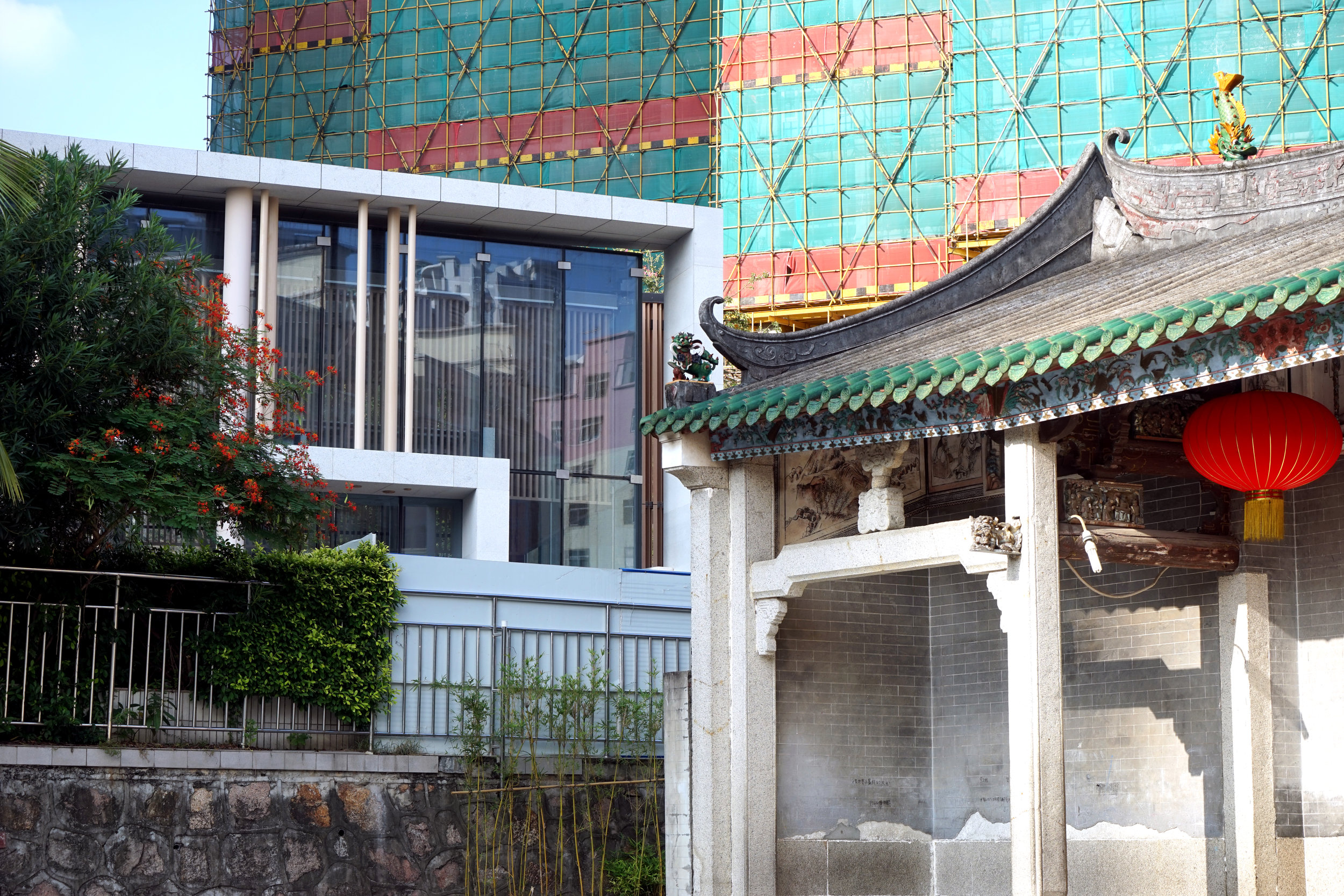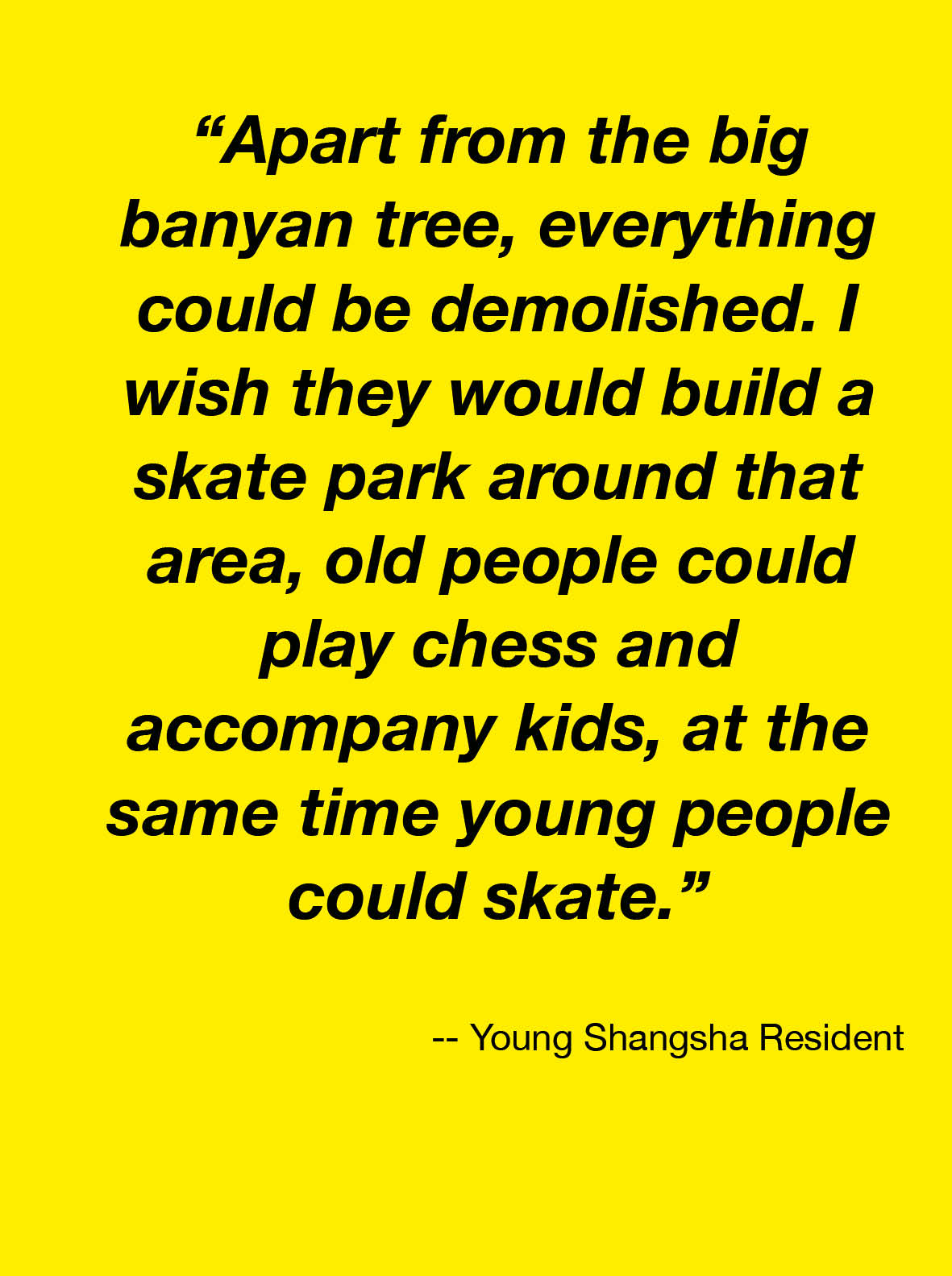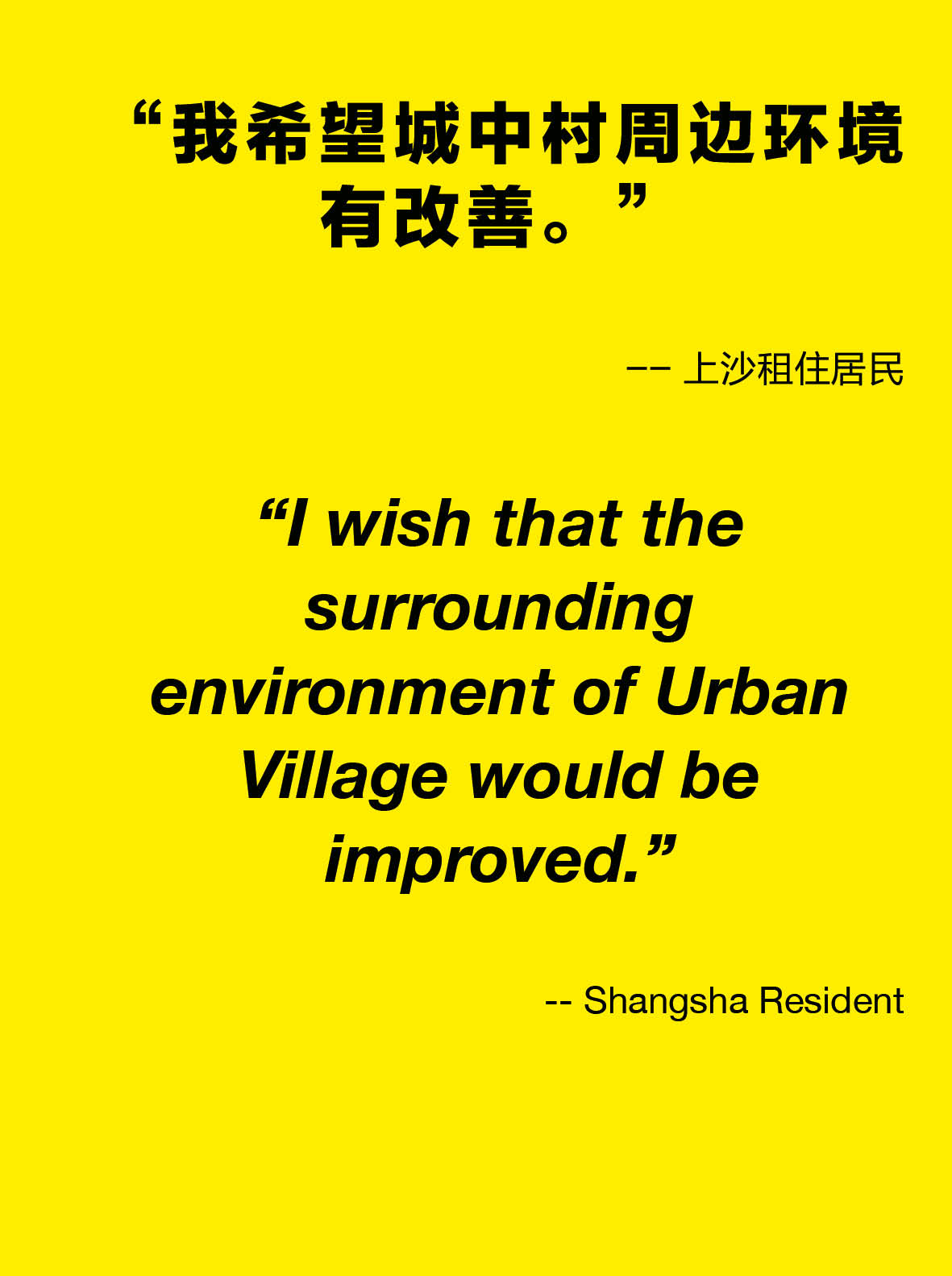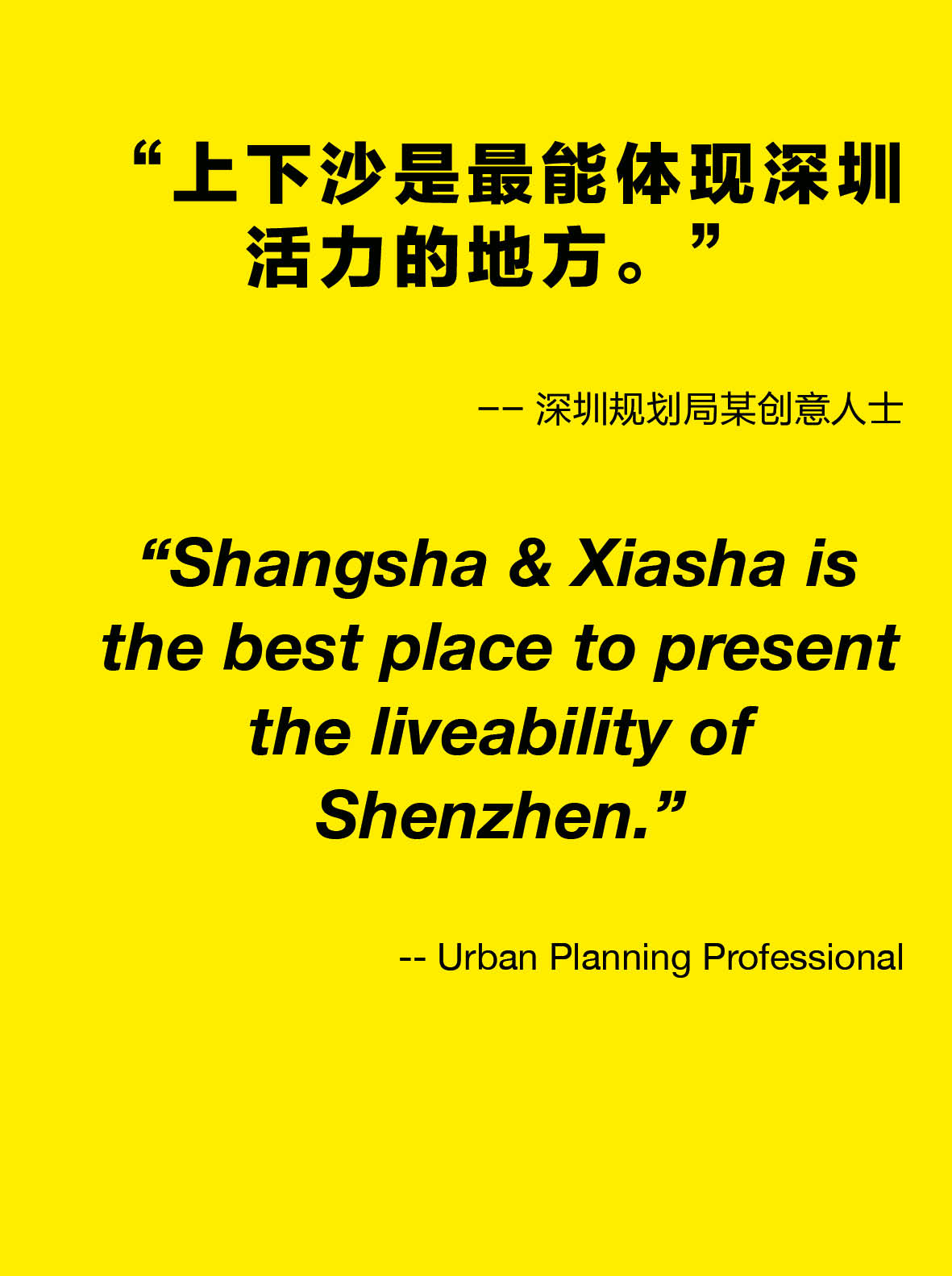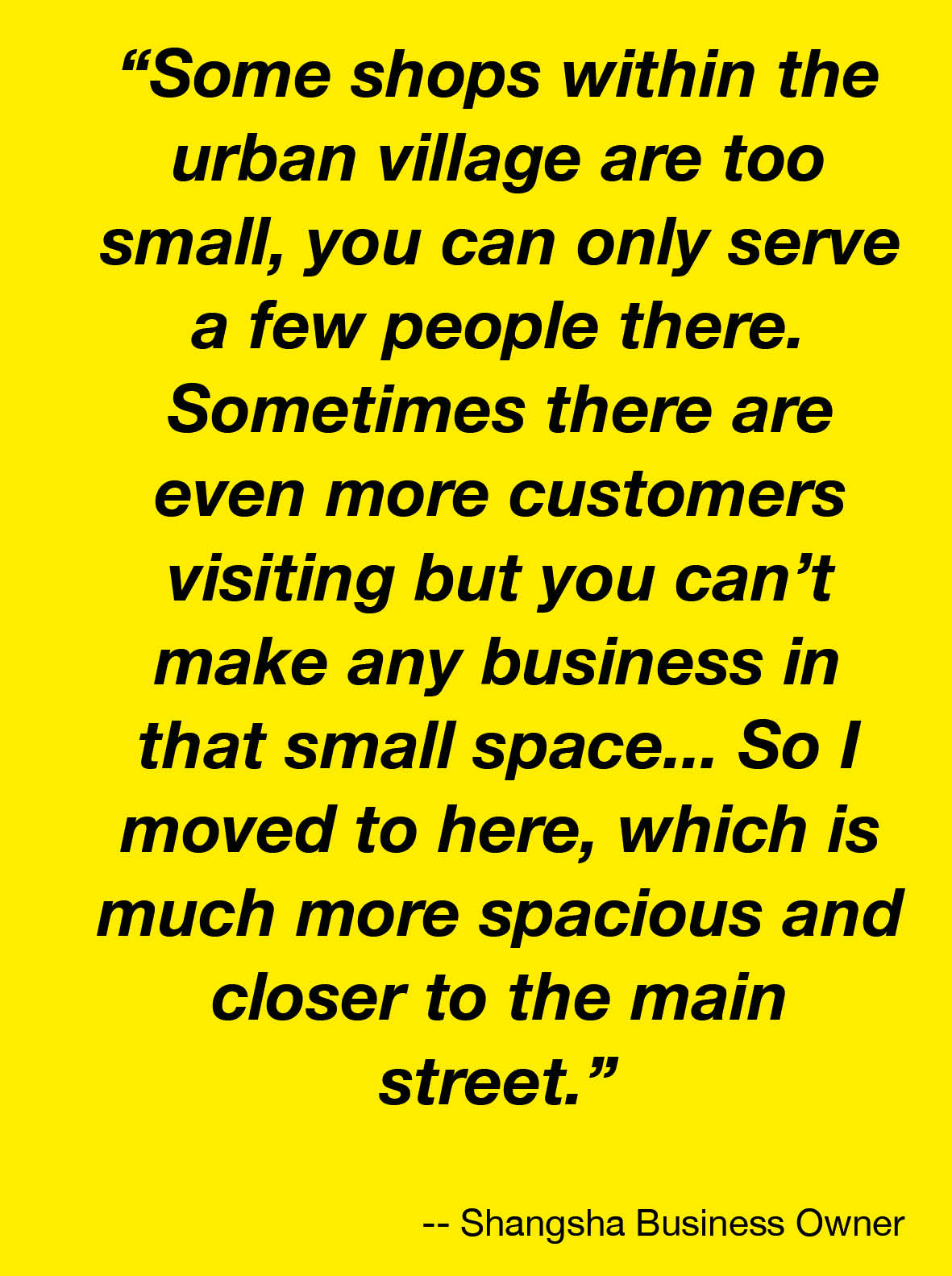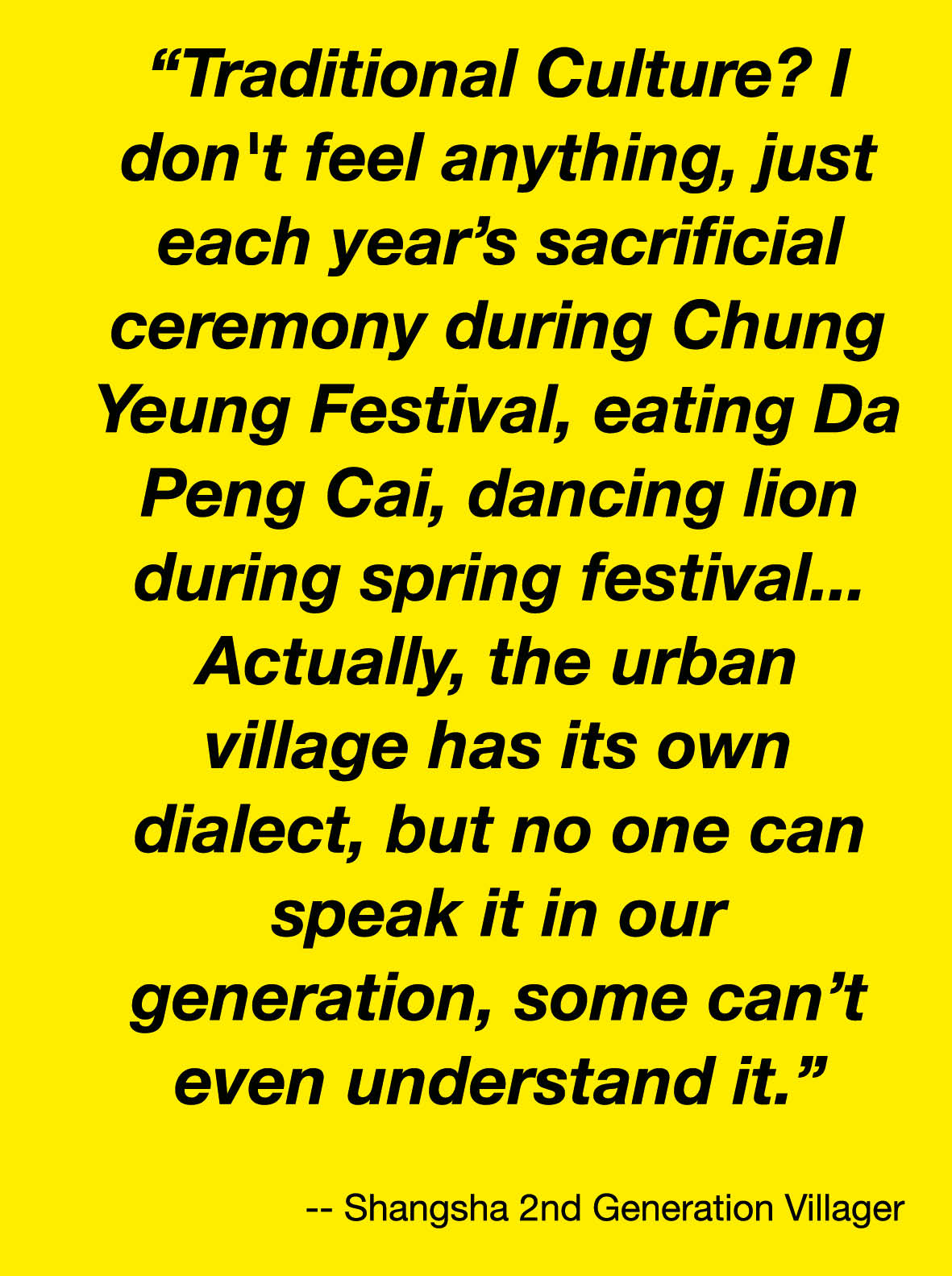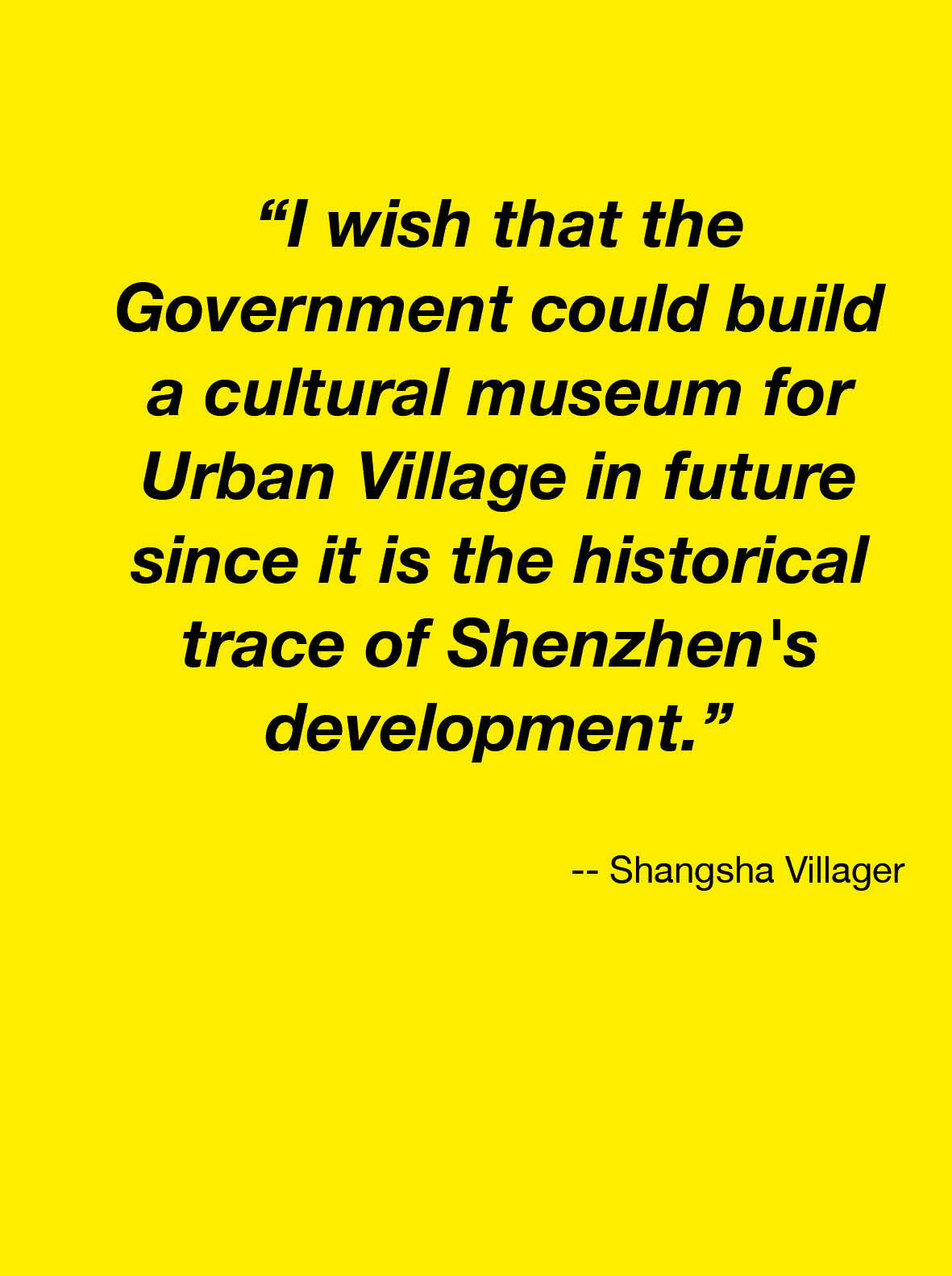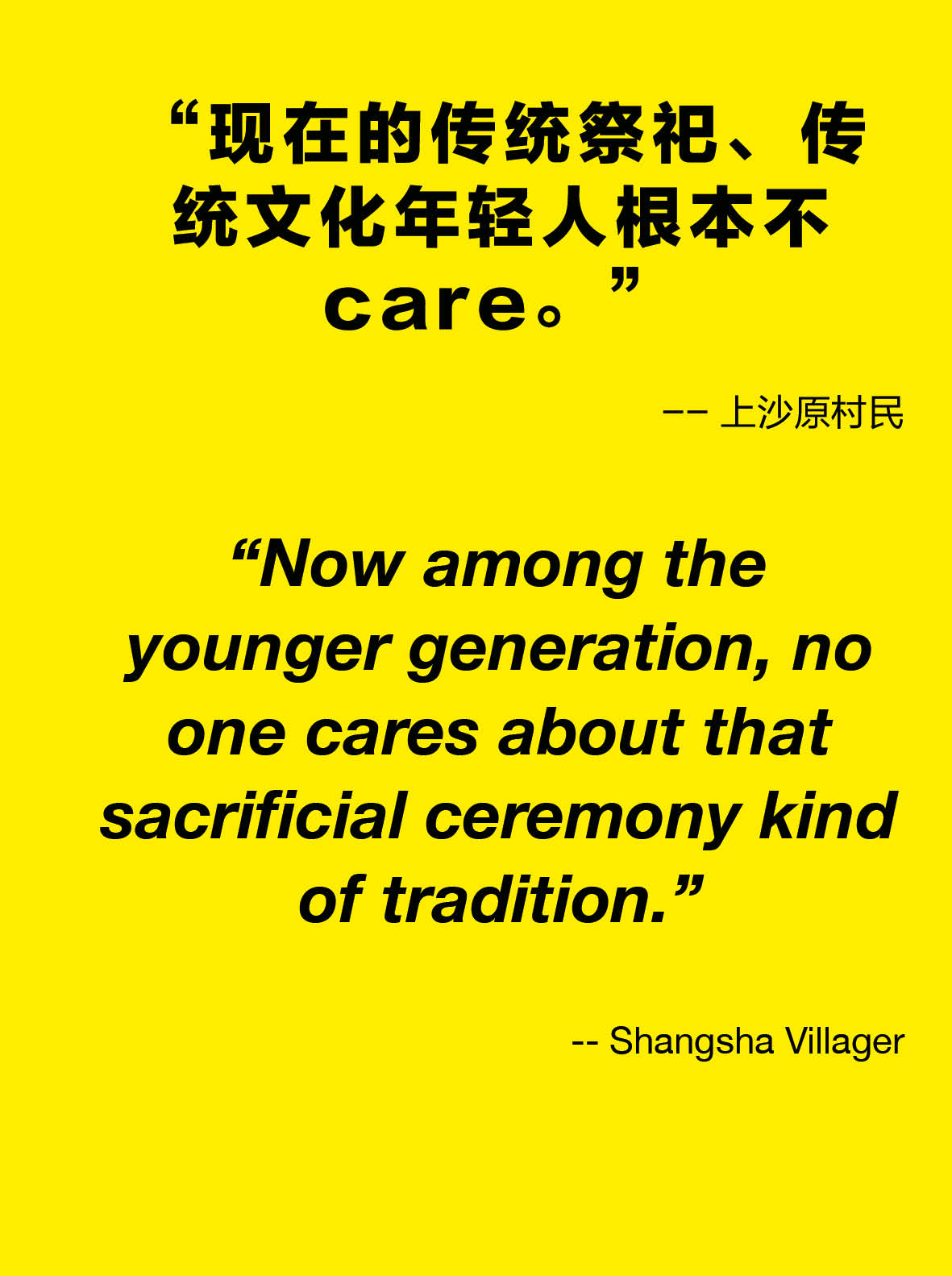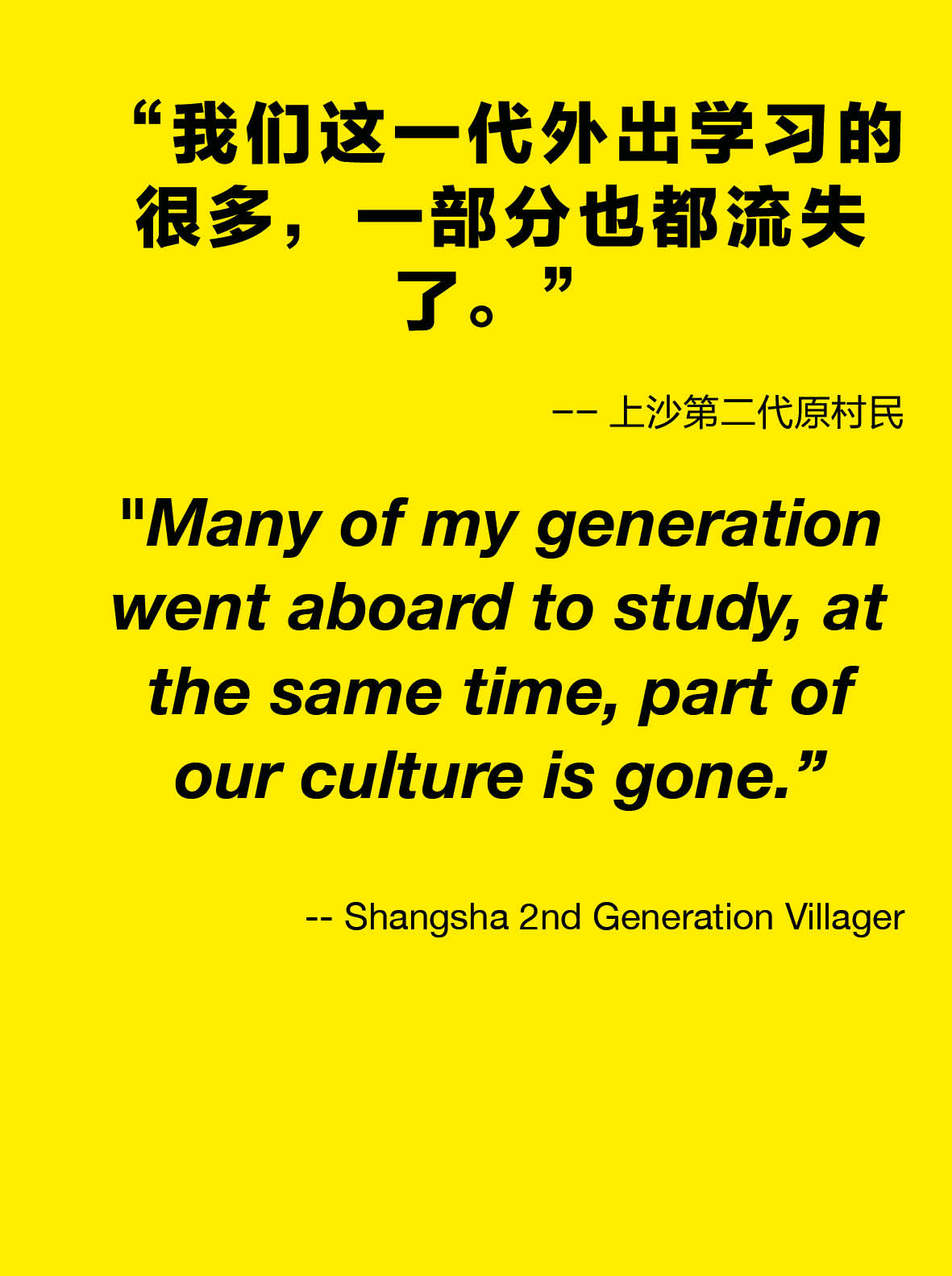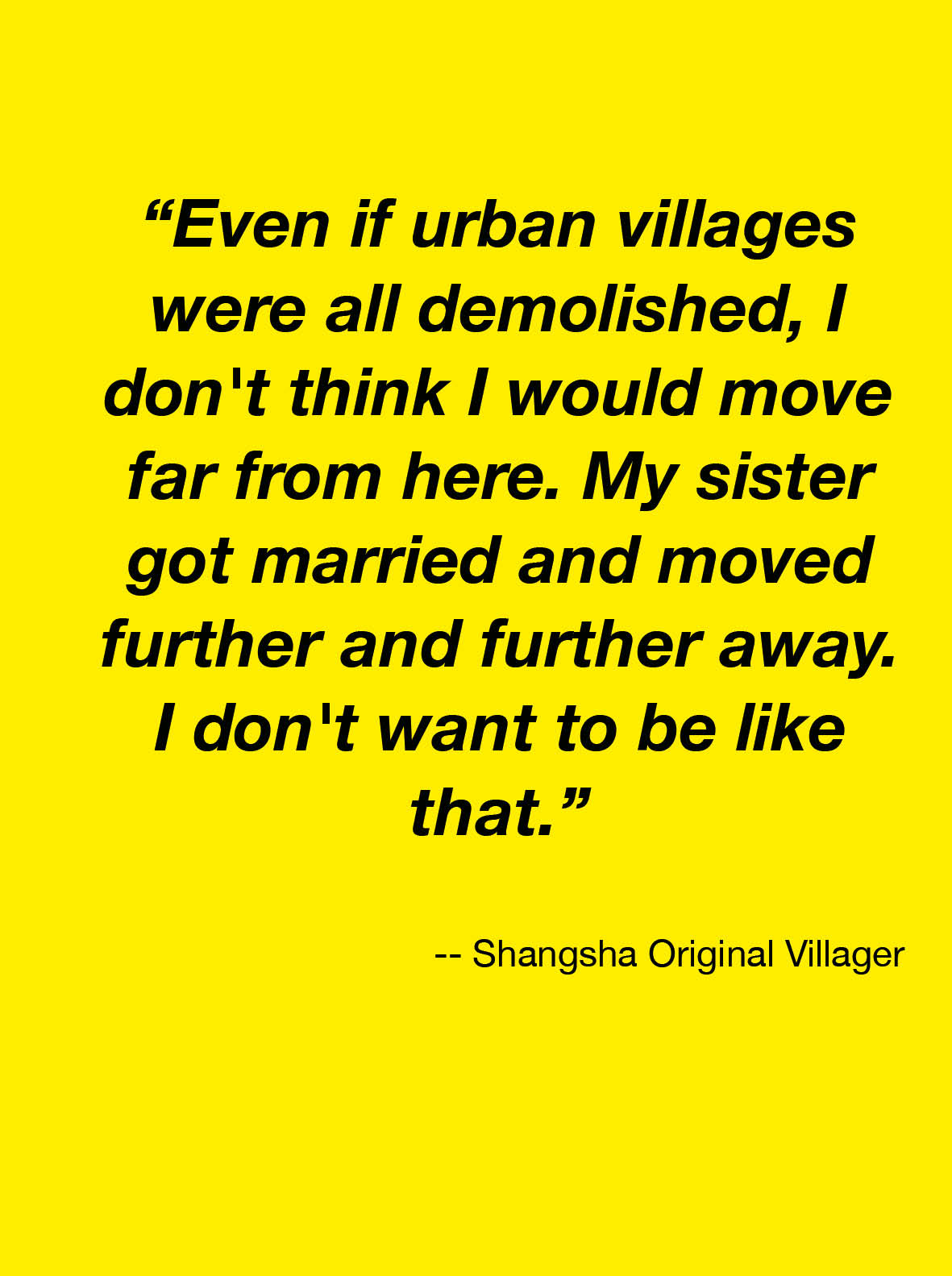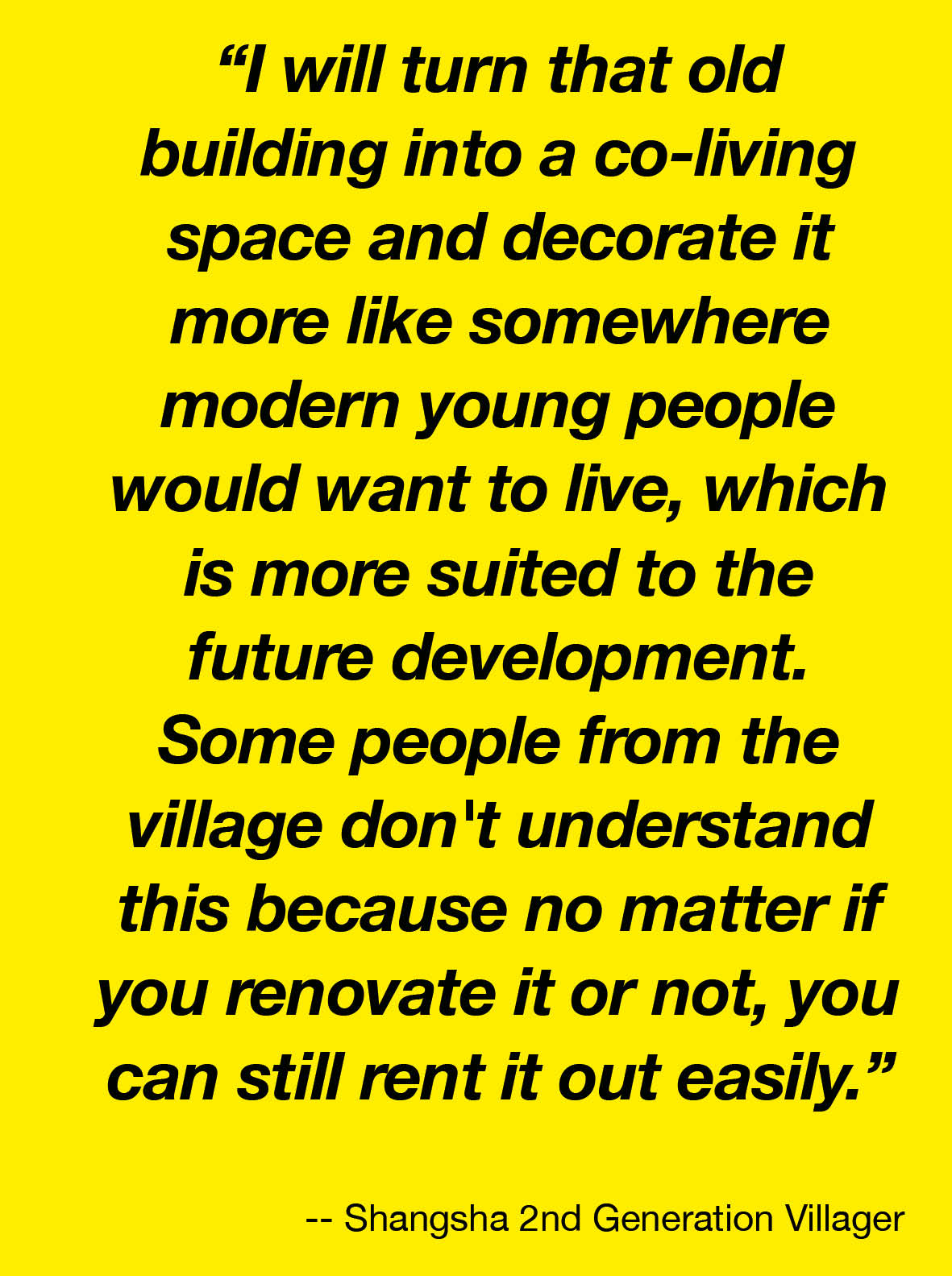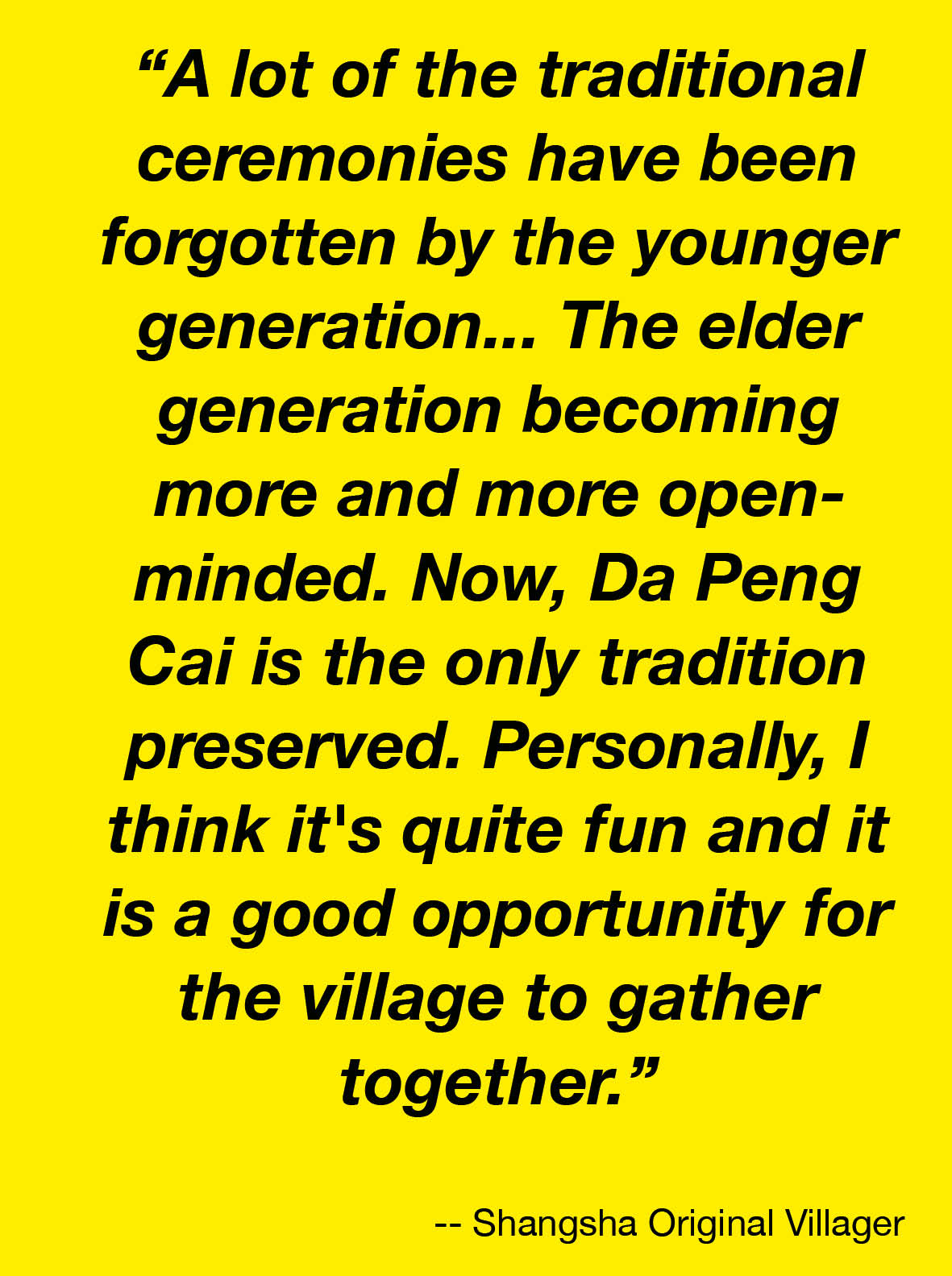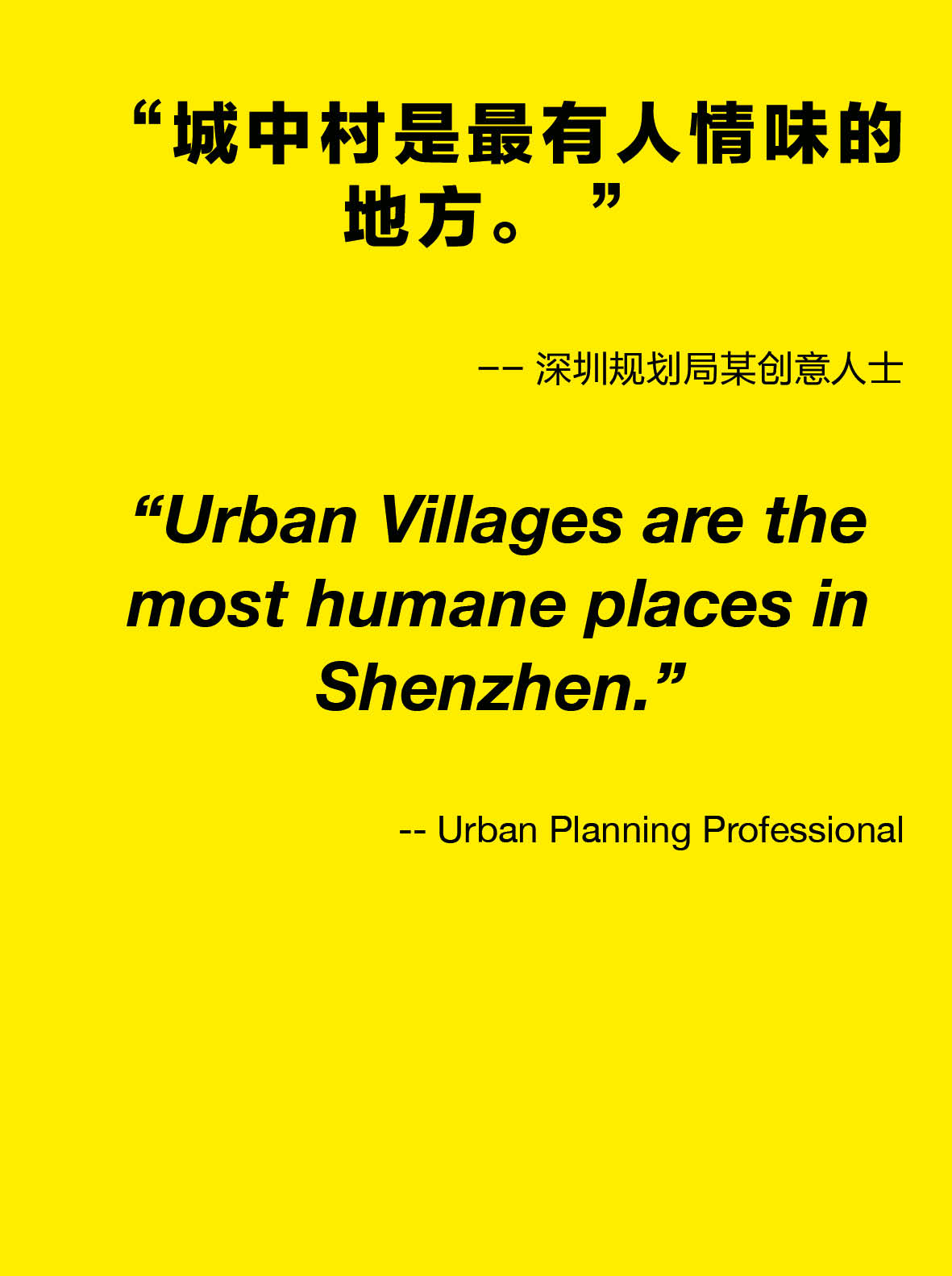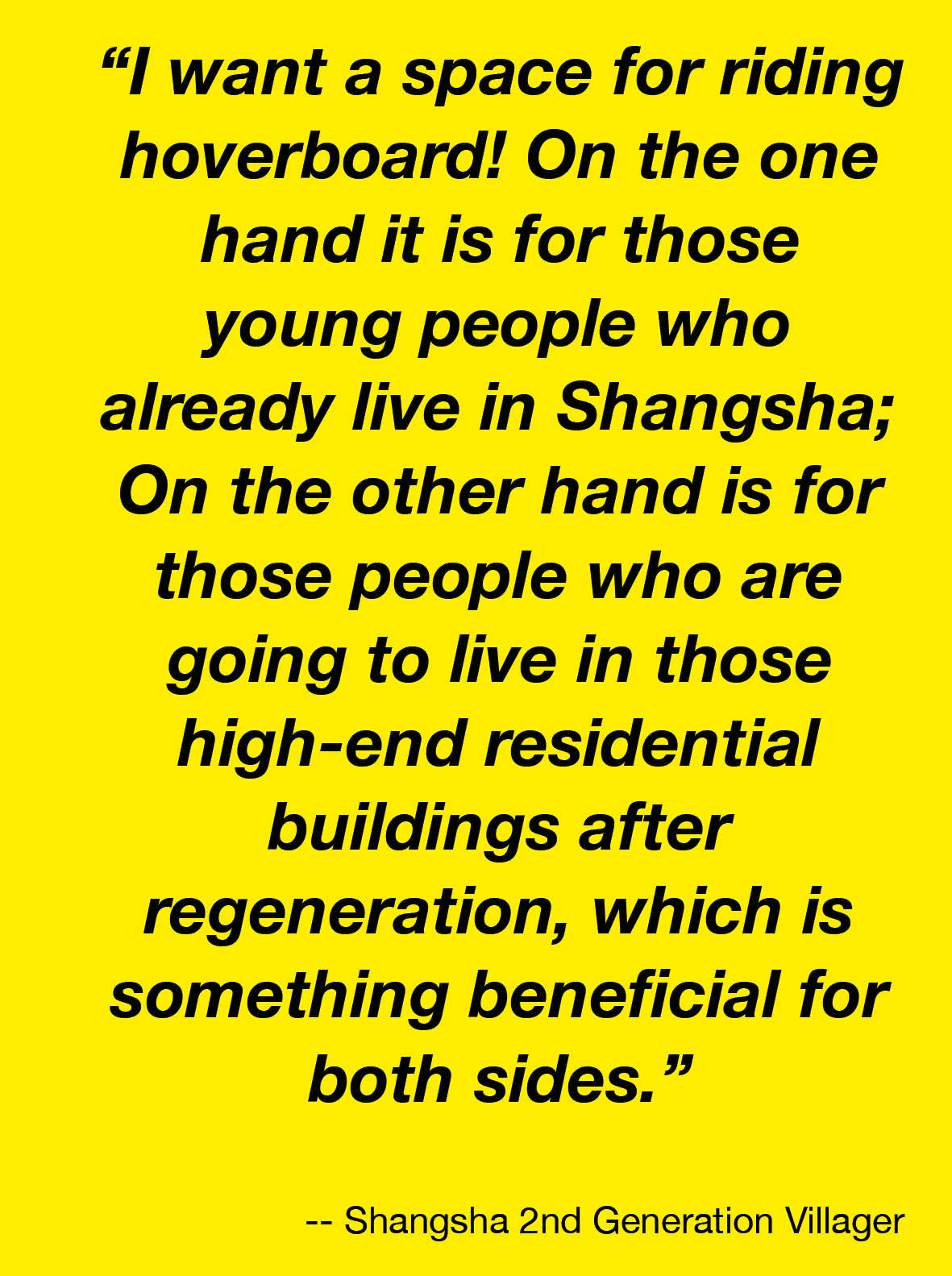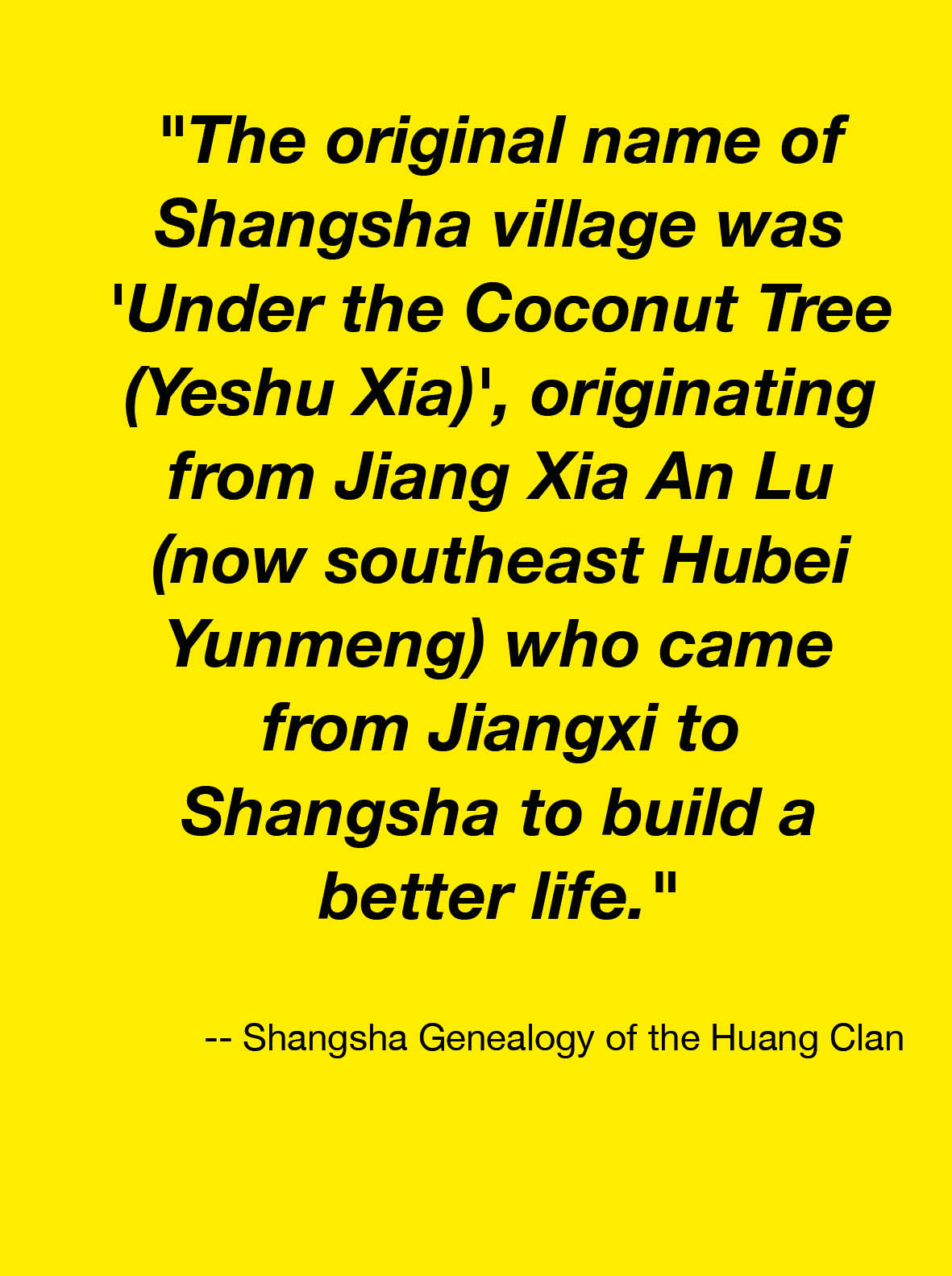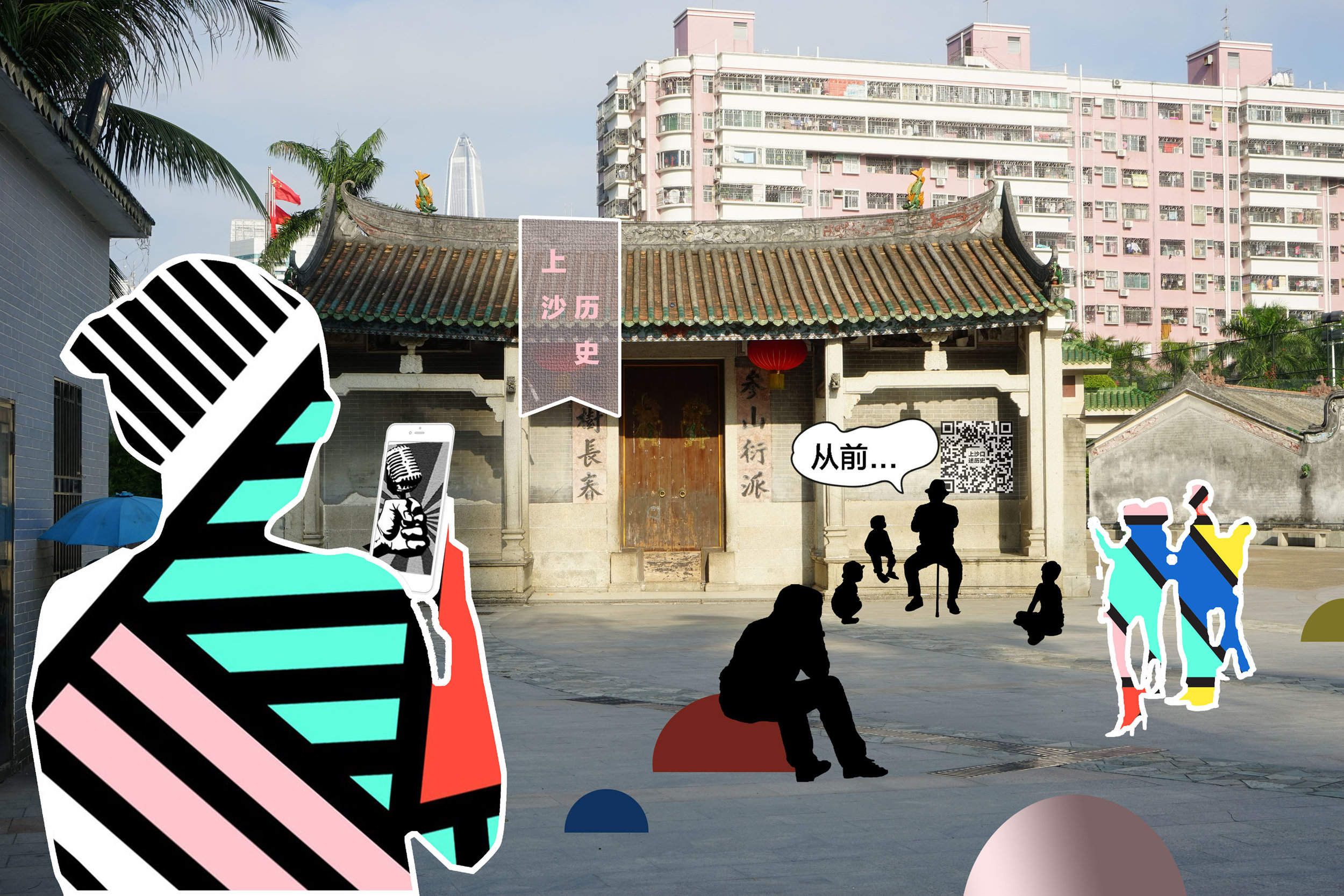PLACING SHANGSHA: Coalescing the Urban Village through Identity
Placing Shangsha is an ongoing project to develop a place-centric brand and bottom-up intervention strategy for an inner city urban village in Shenzhen.
The hypothesis of Placing Shangsha is that urban villages, and Shenzhen at large, is lacking a strong identity around which communities can coalesce and local businesses can leverage.
The project was exhibited during the 2017 Shenzhen/Hong Kong Architecture and Urbanism Biennial.
LOCATION: Shangsha Village, Futian District, Shenzhen
KEYWORDS: Revitalisation / Branding / Urban Village Revaluation / Strategic Planning
CLIENT: Shenzhen Municipal Planning and Land Resources Commission, Futian District Administration Bureau
TEAM: Yijing XU, Neill Mclean GADDES, Kunfang ZHAO, Shiyang HU, Solar JIAO, Xiaohong Huang
COLLABORATORS: URBANUS, Shangsha Enterprise
STATUS: Ongoing (2017-)
SYNOPSIS
Shangsha Village is located in the south west of Futain district, on the northern shores of Shenzhen Bay. As an Urban Village of Shenzhen, it shares many of the same challenges facing Nantou Village and others as the city experiences rapid societal changes, increasing urban growth constraints, nascent international recognition, and meteoric property value increases.
Some of the specific problems identified during research in Shangsha were the growing lack of involvement in the village by younger generation villagers, and a lack of knowledge or respect within the village for its role in the success of the city. Part of the hypothesis of Placing Shangsha is that urban villages, and Shenzhen at large, is lacking a strong identity around which communities can coalesce and local businesses can leverage.
BACKGROUND
Shangsha Village is located in the south-west of Futian District, neighbouring Shazui Villiage to the east, Xiasha Village to the west, Binhai Avenue to the north and Shenzhen Bay to the South. It is comprised of five ‘natural’ villages, namely, Dongcun Village, Tangyan Village, Yeshu Village, Longqiu Village and Jiuyuan Village. By the end of 2016, there were in total 400 permanent households with a registered population of 1020 and a migrant population of over 100,000.
According to the Huang Clan Genealogy of Shangsha:
Shangsha Village was named “Yeshuxia” (under the coconut tree) and was established during the Southern Song Dynasty.
The descendants of Huang Clan from Jiangxia came to the now Xiasha Village from Jiangxi Province and founded their businesses there. It was briefly known as “Shangshatou Village” in the Qing Dynasty, before becoming Shangsha Village.
The villagers of Shangsha Village earned their living by farming and fishing, and thus worshipped the patron of seafarers, Mazu. The Goddess Mazu Temple was first established in the Ming Dynasty. It was the Ancestral Shrine of the Huang Clan and is now a protected place of cultural heritage.
Since 1980 when the Special Economic Zone was established, Shangsha Village has made a great contribution to the development of Shenzhen. Before the establishment of the SEZ, the total area governed by Shangsha Village was 6.67km2. Later on, most of the land was acquired by the government, resulting in the current area of the village being reduced to 0.38km2.
深圳市
In 1992, Shangsha Enterprise Co., Ltd. was formed by the village to manage their collective assets.
In 2002, Shenzhen launched the initiative to “transform residential areas into communities.” Thus, Shangsha Village became Shangsha Community.
Today Shangsha Community has retained many of the traditions passed down through the now urbanised Huang Clan. The villagers still celebrate the Double Ninth Festival and the entire village participates in ancestor worship rituals, with many villagers residing outside of Shenzhen travelling to Shangsha for the occasion. Shangsha Enterprise has worked together with Hong Kong Shangsha Qiaoyu Co., Ltd. to organise Huang Clan relatives to participate in the Ancestor Worship ritual in the Shangsha Cemetery in Lian Tang Wei, as well as the worship ritual held in the Huang Clan Shrine.
Shangsha Enterprise has attached great importance to the respect of the elderly and the education of the younger generation. The authority encourages the villagers and their children to pursue education, granting awards and incentives to the students who excel in both school performance and personal development. The community also established the Shangsha Nursing Home as a suite of apartments reserved especially for the elderly. An Opera Gala Show is staged every year for the elderly and they also enjoy a monthly welfare benefit and yearly consolation money during Spring Festival.
In 2013, Shangsha Village started its Urban Renewal Plan which focused on the demolishing and reconstruction of parts of the village as well as comprehensive renovation of the remaining buildings. The overall planning of neighbouring Xiasha is also included in the scope of renewal. Phase 1 of the project involves the construction of the Shangsha Technology Park with a total area of 156,000m2 encompassing retail, office, and residential programs, as well as allocations of new public spaces for the village as a whole.
上沙社区
“Shangsha & Xiasha is the best place to present the liveability of Shenzhen.”
OBSERVATIONS
CONNECTIONS
Shangsha boasts many geographic advantages to its integration with the city. Located in the south-west part of Futian District (arguably the heart of Shenzhen) Shangsha is adjacent to the central business district of Futian and falls within the Greater Jinsha Area, the coastal area comprising Shangsha, Xiasha, Shazui and Shawei. It is serviced by major thoroughfares Binhe Avenue, Fuqiang Road, Xinzhou Road and Furong Road, as well as having a dedicated metro station one stop west of Chegongmiao, a major interchange of the Shenzhen Metro system.
ENVIRONMENT
Greater Jinsha Area boasts the only intertidal zone and the mangrove wetland alongside the coastal line in Futian District, which endows the area with abundant natural landscape resources. The Shenzhen Bay Greenway and Mangrove Ecology Park also sit in this area. Directly north of the village is Futian Sports Centre, which includes playing fields, a running track, tennis courts and a public swimming pool.
DEMOGRAPHICS
Thanks to the advantages in geographic location and natural environment, Shangsha has attracted a large population of young people who contribute to the dynamism of urban villages and Shenzhen at large.
CULTURE
The village values the clan culture and keeps well-maintained ancestor shrines within the village alongside other cultural facilities. The Shangsha Culture Square was established in 2004 and covers an area of 14,000 m2. It consists of performance stage, sports ground, leisure activity facility and community activity centre. The Shangsha Community Library was also established by the village in the Culture Square.
COMMUNITY
The village runs a series of community events such as the celebration of Double Ninth Festival, Da Pen Cai feasts, and Neighbourhood Festival. Shangsha has also organised their own football team, Taichi team, and square dance team.
POTENTIAL
This Greater Jinsha Area is the first large area designated by Shenzhen to implement holistic planning and clustered renewal strategy. This makes it one of the largest areas currently undergoing urban renewal in Futian District. One outcome of this is an increased sense of comparison and competition between Shangsha Village and neighbouring Xiasha Village. Currently, Phase I of Shangsha Community’s renewal has started, with the planning for Phase II has been completed. Compared with neighbouring Xiasha Community, whose spacial layout and infrastructure have been already been upgraded, Shangsha Community enjoys more potential for both hard and soft infrastructure development and spatial improvement.
QUOTES FROM THE COMMUNITY:
PROBLEM IDENTIFICATION
Do the younger, second generation of villagers who grew up in the rapidly developing modern city care about the cosplay-like ceremonial worship activities that seem old-fashioned and ultimately irrelevant? What is the incentive to develop the consciousness of their clan as the older generation did in the past? Can the geographic clan bond still be found within the younger generation as the city undergoes renewal and the village develops and merges further and further with the city? These might be the biggest challenges in cultural inheritance for the older generation who have retained well the traditions and cultures while facing the rise of their children.
“Traditional Culture? I don’t feel anything, just each year’s sacrificial ceremony during Chung Yeung Festival, eating Da Peng Cai, dancing lion during spring festival... Actually, the urban village has its own dialect, but no one can speak it in our generation, some can’t even understand it.”
1. What does Shangsha Enterprise care about asides from the development potential of the land?
During our survey, Shangsha Enterprise expressed concern that suggestions or interventions on the use of existing space might negatively impact the interests of the company and that of its shareholders. However, they still welcomed the local reconstruction and renewal. during multiple interviews with the company, they repeatedly mentioned the following;
“After the renewal, we will have a better museum than Xiasha!”
“The company attaches great importance to the culture we live up to. And we would like to build a cultural corridor.”
“If you could deliver high-quality and upscale results, we will spare no effort to support your work.”
Shangsha Enterprise clearly values the inheritance of local culture. This was direction through which a more engaging relationship between us, the company, and the village as a whole could be built upon. We then begin to hypothesis the nature of this direction based on the comments by the leadership and the literature we had in hand. This included the historical record of the village and the photos of its activities, like the Da Pen Cai served during the ancestor worship rituals, etc.
2. Is the cultural generation gap in Shangsha a universal phenomenon?
After we put forward the first hypothesis, we soon realised that it was actually a question of a cultural-generational gap. The two generations, who have been raised in vastly different circumstances hold different, or even conflicting, cultural perceptions. Such conflicts and clashes occur every day from the family level to the national level. Thus, here came the second hypothesis:
In a society like Shenzhen’s, which is developing and changing at an accelerating rate, the cultural generation gap existing in Shangsha is not specific, but rather a universal condition. We would have to explore the universal nature of this phenomena to define what is an ultimate cause (and therefore beyond our scope to intervene) and what is a root cause that can be targeted.
3. Are there analogues in other fields successfully bridging this cultural gap?
Viewing the issue of cultural-generational gap outside of the specificity of the Urban Village, some hope arises that this issue can be surmounted. One phenomenon from which we can draw parallels is the relatively recent advent of Folk Art Renaissance in China. Over the past five years, Folk Art has begun to reassert itself back into the cultural landscape of China. The knife sharpening masters who were ignored by young people in the past are now called craftsmen, workshops and ateliers focused on traditional craft have emerged in the cities, while museums are now hosting more porcelain, folk furniture, and bamboo craft exhibitions then before.
An increasing number of young people have started to care about craftsmanship and wish to experience for themselves making with their hands. It is happening in industries and people’s day-to-day life, attracting various types of people from students to social celebrities to pick up the mantle of folk craft from the masters of the previous generation.
“Many of my generation went aboard to study, at the same time, part of our culture is gone.”
This has come about through the action of three distinct forces:
INDUSTRIAL RESTRUCTURING
Industrial restructuring through the transformation from a production based industry to a service based industry base most famously paraphrased as "from Made in China to Innovated in China.” This has resulted in a mining of the country's cultural resources to drive innovation, with folk art and craftsmanship proving fertile ground for inspiration.
NATIONAL PRIDE
Enhanced sense of national pride and recognition of cultural identity has also acted to favour visibly indigenous innovation and production over completely novel or a foreign, appropriated form of innovation. As China's status in the world has improved, its societies national pride has also increased, and while national economic strength increases, society begins to pursue spiritual and cultural improvement, as well as economic.
YOUTH VALIDATION
Younger generations have become the backbone of societal movements like the Folk Art Renaissance. Though it may be the craftspeople or techniques that are the focus and the face of the movement, it is ultimately the acceptance and absorption of such traditions by the youth that has led to their reappraisal and repositioning in society at large. This becomes apparent when observing the differentiation between crafts and techniques that are 'revitalised' versus ones that are simply preserved, the use value of the techniques to the youth, either as a product or a service, drives this difference. This validation transcends age and social barriers because of both a strong representation in media and the aspirations youth represent.
within the specific realm of urban village development, there are another three points to take into account
A. How is the Urban Village understood today?
With the rapid urbanisation of Shenzhen and the enforcement of strict limits to the outward spread of the city, Urban Village's as distinct social and cultural places of the city could soon disappear. Clearly, much transformation has occurred in the past and Shangsha bears little resemblance to the original village that occupied the site, but the distinctiveness as a place and the villagers understanding of the boundaries still exists. Additionally, if the experiences of other cities within China and abroad have taught us, there is almost always regret when losing places that have a cultural, social, historical or economic position in history to demolition.
Traditional real estate companies are not adjusting to industry changes, and are trying to exit the market. It is irrational to rely on these real estate companies to solve the problems in the village. Industrial Transformation is and will continue to affect the urban villages.
Wider structural changes are also influencing decisions about the village. The leasing and financial compensation on resettlement model is not a long-term strategy that can ensure the continued existence of the village. Could the residential housing rental stock of the village match market demand in a more responsive way? Could we carry out urban renewal in the village in such a way as to future-proof the village? These are the questions Shangsha Enterprise are having to consider.
To destroy the current geographic relationships of the urban village will result in the degradation of the clan bond and institutions based on such geographic relationships. Though it is occurring slowly, it is changing the relationship structures among the people.
B. How is the Culture and Identity of the village understood today?
Many of the older generation who made their fortunes within the urban villages are now trying to protect and retain the traditions and culture they have inherited. They want to enjoy the spiritual and cultural fulfilment that they missed in the past because they were too busy with their material life. The younger generation does not care about many of the aspects of this traditional culture because it is already far removed from their current life.
Over the past thirty-seven years of reform and opening-up, Shenzhen has received and homed much grass-roots youth, who come to fight for a better future. Most of them have chosen Urban Villages as their first base in the city.
It is an aspect of recent history that the Urban Villages should be proud of, but it is rarely mentioned by the villagers. The grass-roots spirit and culture to fight for a better future are not reflected in the mainstream cultural rituals of the Urban Villages. However, those inspiring individuals and stories are very close to the contemporary life of the city. How could we connect this pursuit and spirit of migrants with the village and establish an image that would benefit the development of the area? Could hybridisation of the traditional village cultural qualities, such as hospitality, and the fighting spirit of optimistic migration be the future of Urban Village culture? Could this also recast the role of the village in the city as a key social asset and critical to its success?
“The original villagers of Shangsha were migrants searching for a better future. Their determination and strength in pursuing that goal make up the DNA of Shenzhen. These cultural strains should never be separated.”
“I’ve been living and doing business here for 20 years, even if I move out in future, I will still do business here.”
C. How are the youth involved in the Urban Village today?
The 'second' generation of the original villagers have grown-up with Shenzhen, they are well educated and open-minded. The children of the original villagers are the future owners of the urban village. They have the right and responsibility to strengthen the area; they are its guardians.
Are they more aware of what the Urban Village is? What do they expect for future development?
At the same time, migrant youth living in the Urban Villages should also participate in the future advancement of the area with the second generation villagers. If allowed, they can endow the Urban Village with greater diversity and energy. The energy from the youth could be used to attract people from all age groups. Curiosity and the yearning for communication can be found in people from any age group or social class. Greater communication between these two groups would be a powerful tool to mobilise the dynamism of the community.
We should empower the younger generation in the Urban Village and listen to their ideas and dreams, they are the ones who are closest to the future.
How do we Breakthrough?
Part 1: The Relationship Between Land and Villagers
In rural areas, villagers rely on farming the land to earn their living. It is by far the most important commodity they have for economic production, without the land, the village would (and has) disappeared. The land is also an important commodity for the villagers living in Urban Villages, though rather than farming they collect rent. It is a limited commodity that, just as with rural land, needs to be managed efficiently and sustainably to generate high returns over time. Would the suggestion to develop new public space for community empowerment, with the limited land resources available in Shangsha, hurt the interest of the villagers? In which way(s) would the villagers be willing to compromise their own immediate interests for a promised but not guaranteed return in the future? Is there a way to ensure villagers and residents both win from intervention in the village?
It is a question that no village in China (urban or otherwise) could avoid answering: What is the relationship between The Land as a commodity and The Village as a social, cultural and economic construct?
Part 2: The Definition of Community Empowerment
When we mentioned the idea of “Community Empowerment” in Shangsha, the Community Management Committee and the leadership of Shangsha Enterprise said that they had both heard of the concept and seemed to welcome the potential political implications that achieving this would entail. Only, there is no developed case that we could use to explain the rationale of community empowerment and the significance of what it could achieve. There is no point struggling with explaining the concept, in moving forward, there are few options but to prototype interventions onsite that could prove the concept to both stakeholders.
A prototype of an empowered community needs to prove it can identify pain points and demands, and solve these issues with its own strength and understanding of itself.
PLACING SHANGSHA: PURPOSE
Develop Open Identity
Revive Cultural Pride
Reconnect Community
MODEL
How could space in the village be revalued?
How does traditional culture enter daily life?
How could local entrepreneurialism be supported?
How can social services within the village be improved?
RADIATING IMPACT
Placemaking
Placemaking is one of the more granular activities we can engage in to increase the quality of life in the city. It is also an activity that for relatively little investment can drastically improve the perception of the city. By utilising inherent qualities grounded in a place; and by opening these qualities up to residents, visitors, and businesses; we directly influence people’s experience of the city. Introducing granular placemaking leads to radiating impacts for the city, from visibility (Branding) to differentiation (diversity) to enjoyment (liveability.) These impacts are sequential: Branding can seem hollow without a strong sense of place underlying it, while diversity can be difficult to comprehend without the signifier of the brand.
Branding
Place or neighbourhood branding can become a truly social asset for the city when it represents an original and tangible Identity of Place. The brand becomes short-hand for the cultural, social, environmental and commercial qualities that constitute a neighbourhood. It becomes the language leadership can use to describe and differentiate what they do. It becomes an asset local business can leverage within their own branding, and it can become a node about which community pride and civic responsibility can coalesce. What it does not need to be is a logo or empty slogan, because if a brand does not align with experience it holds no power to represent Place.
City Diversity
Cities are but a sum of their parts, and as such, diverse and interesting neighbourhoods work hand in hand with infrastructure and public services to create a great city. This diversity comes about via physical aspects of a neighbourhood such as period built or natural features, socioeconomic situation, ethnic populations, and cultural amenities. But it can also be augmented by strong identities of neighbourhoods, the soft infrastructure like branding and association of a neighbourhood name with the qualities which it embodies. With a greater number of diverse places, cities become dynamic and interesting places to live and work.
Quality of Life
Shenzhen has great amenities and public services. It’s public transport system, parks, business opportunities, and connectivity are all world class. As such, Shenzhen often tops QOL rankings within China. However, when more qualitative metrics such as culture are included within these rankings, Shenzhen loses out to cities like Beijing, Shanghai and Guangzhou... If Shenzhen wants to attract key talent, and receive the recognition as a international metropolis it seeks, developing soft infrastructure through culture and community is key. This does not necessarily mean building more museums. Rather, an authentic, indigenous Shenzhen Culture that leverages its youth and vitality must be developed from the bottom up.


